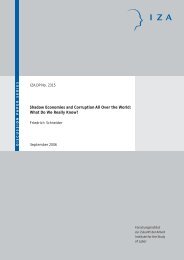The Great Recession of 2008-2009: Causes ... - Index of - IZA
The Great Recession of 2008-2009: Causes ... - Index of - IZA
The Great Recession of 2008-2009: Causes ... - Index of - IZA
- TAGS
- recession
- index
- ftp.iza.org
You also want an ePaper? Increase the reach of your titles
YUMPU automatically turns print PDFs into web optimized ePapers that Google loves.
5 From recession to recovery<br />
5.1 Economic recovery only slowly taking hold<br />
Towards the end <strong>of</strong> <strong>2009</strong>, a variety <strong>of</strong> indicators showed that the worst <strong>of</strong> the global financial<br />
crisis was over in most countries. Stock markets have recovered from their nadir that was<br />
evident in March <strong>2008</strong> and also exhibit far less volatility than at the height <strong>of</strong> the crisis<br />
(World Bank 2010). Third quarter figures for GDP did indicate that most OECD countries<br />
technically exited recession (besides Greece, Hungary, Iceland, Spain and the UK). 43 At the<br />
same time, one is even witnessing an incipient asset price boom. Later in <strong>2009</strong>, trade and<br />
industrial production statistics suggested that a recovery is underway. Figures on<br />
manufacturing activity in China, Europe, the US, and other badly-hit countries indicate that<br />
the global recovery was beginning to strengthen at the start <strong>of</strong> 2010. Most notably, US<br />
industrial activity reached its highest level since August 2004.<br />
However, growth figures for the last quarter <strong>of</strong> <strong>2009</strong> reveal that this exit from recession is not<br />
as robust as first thought. In particular, growth in the European Union has slowed down (from<br />
0.3% in <strong>2009</strong>Q3 to 0.1% in <strong>2009</strong>Q4). Growth in Czech Republic and Italy fell back into<br />
negative territory, while Greece, Hungary, and Spain continued to contract (data for Iceland<br />
not available). Expansion in the US and Japan appeared to gather pace, though some <strong>of</strong> this<br />
has been argued to be driven by the ‘inventory effect’ (i.e. business have run down stocks and<br />
have started replenishing their inventory), which will not continue to be an engine <strong>of</strong> growth<br />
over coming quarters. 44<br />
Looking at the recovery from a more comprehensive perspective reveals that despite the<br />
return to positive economic growth late in <strong>2009</strong>, most advanced economies are still in a<br />
vulnerable situation, particularly when judged from the standpoint <strong>of</strong> workers’ welfare. As<br />
reported in Table 9, 20 OECD countries have technically exited recession by the fourth<br />
quarter <strong>of</strong> <strong>2009</strong> (out <strong>of</strong> 30 countries). <strong>The</strong> Czech Republic, Germany, Italy and Portugal grew<br />
in <strong>2009</strong>Q3 before growth stalled in the last quarter <strong>of</strong> <strong>2009</strong>, reflecting the fragile nature <strong>of</strong> the<br />
recovery.<br />
43 See figures from the IMF’s World Economic Outlook Database, October <strong>2009</strong>,<br />
http://www.imf.org/external/pubs/ft/weo/<strong>2009</strong>/02/weodata/index.aspx.<br />
44 See ‘Manufacturing surges back’, Financial Times Europe, Tuesday, February 2, 2010, and Economist<br />
Intelligence Unit (EIU) ‘World economy: unsustainable recovery’, ViewsWire, January 20, 2010.<br />
47
















